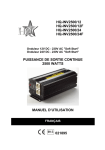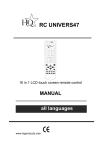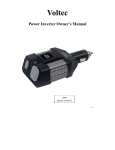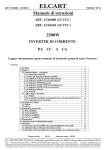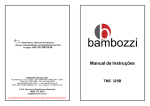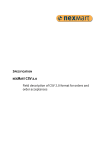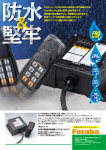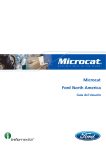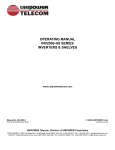Download HQ -INV2500/12
Transcript
HQ-INV2500/12 HQ-INV2500/12F HQ-INV2500/24 HQ-INV2500/24F 12V DC to 230V AC Soft Start Power Inverter 24V DC to 230V AC Soft Start Power Inverter 2500 WATT CONTINUOUS OUTPUT POWER MANUAL ENGLISH 021895 SAFETY PRECAUTIONS: To reduce risk of electric shock, this product should ONLY be opened by an authorized technician if service is required. Disconnect the product from mains and other equipment if a problem should ocure. Do not expose the product to water of moisture. WARRANTY: No guarantee or liability can be accepted for any changes and modifications of the product or damage caused due to incorrect use of this product. GENERAL: Designs and specifications are subject to change without a notice. 1. SPECIFICATION Spec. Output power Input voltage Output voltage Output waveform Output frequency Stand by current Efficiency High voltage input shutdown Battery low alarm Battery low shutdown Thermal protect Cooling Protections Fuse AC outlet Size ( L*W*H ) Weight DC12V 2500W continue 5000W surge output DC10 ~ 16V AC 230V Modified sine wave 50 or 60HZ DC24V 2500W continue 5000W surge output DC20 ~ 30V AC 230V Modified sine wave 50 or 60HZ ﹤0.7A 85% ~ 90% DC16V+/-0.5V ﹤0.6A 85% ~ 90% DC31V+/-0.8V DC10.5V+/-0.5V DC10+/-0.5V DC21+/-0.8V DC20+/-0.8V 60+/-5°C Fan start when the temperature reach 40°C 60+/-5°C Fan start when the temperature teach 40°C * output short * input polarity reverse(by fuse) * high DC input voltage * battery low alarm * battery low shutdown * over load * over temperature 30A * 12pcs 15A * 12pcs Two Two 430*210*159mm 430*210*159mm 8.7kgs 8.7kgs 1 2.INSTALLATION Mount the inverter horizontally or vertically on a flat surface. CAUTION! Make sure to following these rules when installing the inverter: 1. Make sure the inverter stays dry 2. The inverter should be installed in a cool place, ambient temperature between 0-25°C. 3. To avoid fire hazard and overheating, do not cover or obstruct the ventilation openings of the inverter. Regularly check the ventilation openings because these especially collect dust and dirt. Also keep at least 2,5cm space around the inverter for air flow. 4. To avoid risk of fire and explosion, please do not install the inverter close to or next to flammable substances or batteries. 3. OPERATION 3.1 OUTPUT PANEL INSTRUCTIONS 2 2.1.1. ON/OFF switch For turning the inverter on/off. 2.1.2. Remote ON/OFF jack Allows you to mount the inverter out of sight and turn ON or OFF with the included remote control 2.1.3. Battery voltage (VOLTS) indicator The battery voltage indicator displays the voltage at the input terminal of the inverter. 2.1.4. Battery current (AMPS) indicator The battery current indicator displays the current drawn from the battery by the inverter. Current should be in the green zone for continuous operation. In yellow zone the inverter will work for several minutes, in the red zone the inverter protection will shut down the inverter. 2.1.5. POWER indicator When connected to a battery and switched on, the power indicator illuminates green color: ready for use. 2.1.6. OVER TEMPERATURE indicator The over temperature indicator illuminates in yellow when the inverter is overheated. Also an alarm will sound and the inverter will shutdown. Overheating is caused by operating the inverter with power levels above its 2500W continuous output. Also it will occur when it is installed somewhere where it cannot lose its heat properly. The inverter will automatically restart when cooled down. 2.1.7 OVERLOAD indicator The indicator will illuminate in red when an overload occurs. Problem can be solved by switching it off and reducing the load before switching it on again. 2.1.8 AUDIBLE ALARM Alarm will sound in case of: a. Over temperature b. Low battery (<10.5V for 12V inverter, <21V for 24V inverter) c. Low battery shutdown (<10V for 12V inverter, <20V for 24V inverter) 3 2.2 INPUT PANEL AND INSTRUCTION 2.2.1 FAN For cooling the inverter during operation 2.2.2 TERMINAL CONNECTOR Use red battery cable to connect (+) of the battery to the (+) terminal of the inverter. Then use the black battery cable to connect the (-) of the battery to the (-) terminal of the inverter. Tighten the screws of the DC input cables regularly. When connected to a battery, please make sure to turn on inverter first, before turning on the connected appliance(s). When using the inverter with several appliances at the same time, turn the appliances on separately after the inverter is already turned on. This will ensure that the inverter doesn’t have to deliver all start up currents for all the loads at once . CAUTION! Please attend to 220V AC power is potentially lethal, don’t work on AC wiring while the wiring is connected to the inverter (even if it is switched off) unless the DC power source is physically disconnected from the inverter . Also don’t work on AC wiring if it is connected to another AC power source such as a generator or the utility line . CAUTION! Do not reverse input! Don’t use “alligator-clips” and always ensure the ON/OFF switch on the output panel of the inverter is switched to the OFF position before connected the battery or other DC power source! 4 2.2.3. CHASSIS GROUND LUG The inverter has a lug which is to connect the chassis of the inverter. The ground wire in the AC junction box on the output panel of the inverter is connected to the chassis . The chassis ground lug must be connected to a grounding point, which will very depending on where the inverter is installed. In a vehicle, connect the chassis ground lug to the chassis of the vehicle. In a boat, connect to the boat’s grounding system. In a fixed location, connect to earth ground by a ground rod (a metal rod pounded into the earth), or other proper service entrance ground. Use a #12 AWG or larger copper wire ( preferably with green/yellow insulation ) to connect the chassis ground lug to the grounding point . The neutral (common) conductor of the inverter’s AC output circuit is connected to chassis ground .Therefore, when the chassis is connected to ground, the neutral conductor will also be grounded. This conforms to national electrical code requirements that separately derived AC sources (such as inverters and generators) have their neutral conductors tied to ground in the same way that the neutral conductor from the utility line is tied to ground at the AC breaker panel . CAUTION! Don’t operate the 2500W inverter without connecting it to ground . Electrical shock hazard may result . 6. TROUBLESHOOTING Problems 1. Low voltage output Possible causes Using an average reading voltmeter Overload 2. Low voltage output and AMPS indicator in red zone 3. No voltage output and Low voltage input VOLTS indicator in lower red zone 4. No voltage output and a. Inverter switched off POWER indicator no light b. No power to inverter c. Internal fuse open d.Reverse DC polarity 5. No voltage output and VOLTS indicator in upper red zone High voltage input 5 Solutions Use true RMS reading meter Reduce load Recharge battery , check connections and cable Turn inverter on Check wiring to inverter and battery Have qualified electrician to check and replace Have qualified electrician to check replace fuse , please observe correct polarity Make sure that inverter is connected to 12V battery ( 24V for 2500W/24V inverter ) and check regulation of charging system 6. Low battery alarm on all the time and VOLTS indicator below 10.5V ( 21V for 2500W/24V inverter ) a. poor DC wiring Use proper cable and make solid connections b.Poor battery condition Change battery or use new battery Allow inverter cool down and reduce load if continuous operation required 7. No voltage output , OVER Thermal shutdown TEMP indicator light and load in excess of 2500W/250 amperes current input ( or 125A for 2500W / 24V inverter) 8. No voltage output , OVER Thermal shutdown Make sure ventilation TEMP indicator light and openings in inverter are load less than 2500W/250 not blocked and reduce amperes current input ( or ambient temperature . 125A for 2500W/24V inverter ) 9. No voltage output and a. Short circuit or wiring error Check AC wiring for short OVER LOAD indicator light circuit or improper polarity Very high power load Remove or reduce load If after the above easy troubleshooting , this inverter still doesn’t work , please return it to us or have a qualified electrician to check and replace. Don’t open the case or cut out the cord. 7. CAUTION: Do not use the inverter with the following rechargeable appliances: Two particular types of chargers for small nickel cadmium batteries can be damaged if connected to the inverter: a. Small battery operated appliances such as flashlights , razors and nightlights that can be plugged directly into the AC receptacle to recharge . b. Certain battery chargers for battery packs used in hand power tool. These chargers will have a warning label starting that dangerous voltages are present at the battery terminals. This problem doesn’t occur with the vast majority of battery operating equipment . Most of these equipments use a separate charger or transformer that is plugged into the AC receptacle and produces the lower voltage output . If the label on the AC adaptor or charger states that produces the low AC or DC voltage output (less than 30 volts), the inverter will power this adaptor or charger safely without trouble . USE THE CORRECT SIZE AND TYPE OF BATTERY! For most applications of 2500W inverter it is recommended to use one deep cycle battery or more in parallel. More capacity is better because there will be more reserve capacity to prevent the battery to be discharged too far. 6 DECLARATION OF CONFIRMITY We, Nedis B.V. Declare under our responsibility that the product; Brandname: HQ Model: HQ-INV2500/12, HQ-INV2500/12F, HQ-INV2500/24, HQ-INV2500/24F Description: 2500W DC to AC Power Inverter Is in confirmity with the following standards; e-Mark (72/245/EEC, 95/54/EC):e13*72/245*95/94*1895*00 EMC (98/336/EEC): EN 61000-6-3/2001: EN 55014-1, EN 61000-3-2/-3, EN 61000-6-1/2001: EN 55014-2 (EN 61000-4-2/-4/-5/-6/-11) LVD (73/23/EEC): EN 60950-1:2001, EN 61558-1:1997 +A1:1998 Conform this regulation it’s allowed to use this product in all European Community & EFTA countries. Nedis BV is not responsible for the use of this product outside the European Community & EFTA countries. ‘s-Hertogenbosch, 24-01-2006 Mrs. J. Gilad Purchase Director 7 www.hqproducts.info 8









